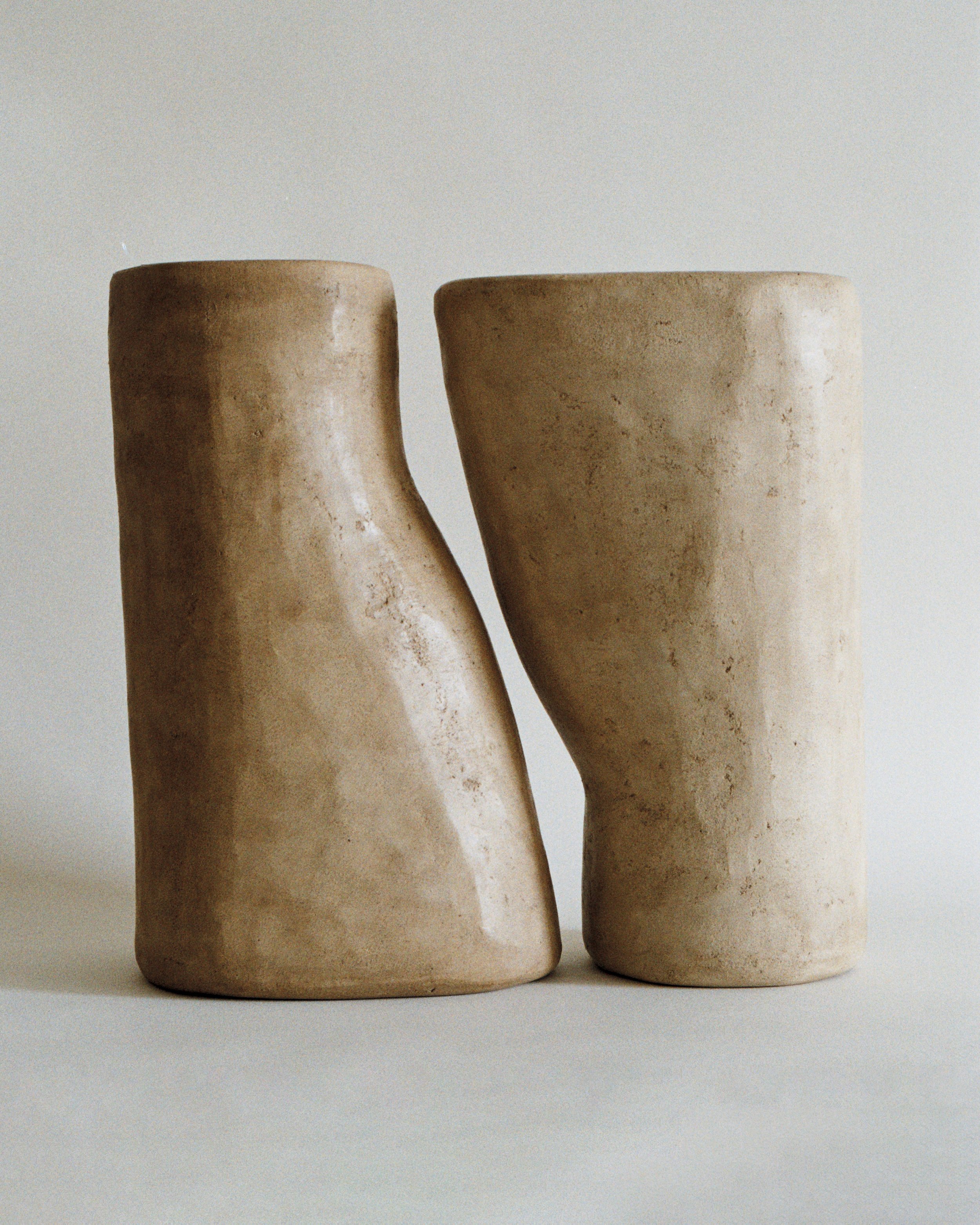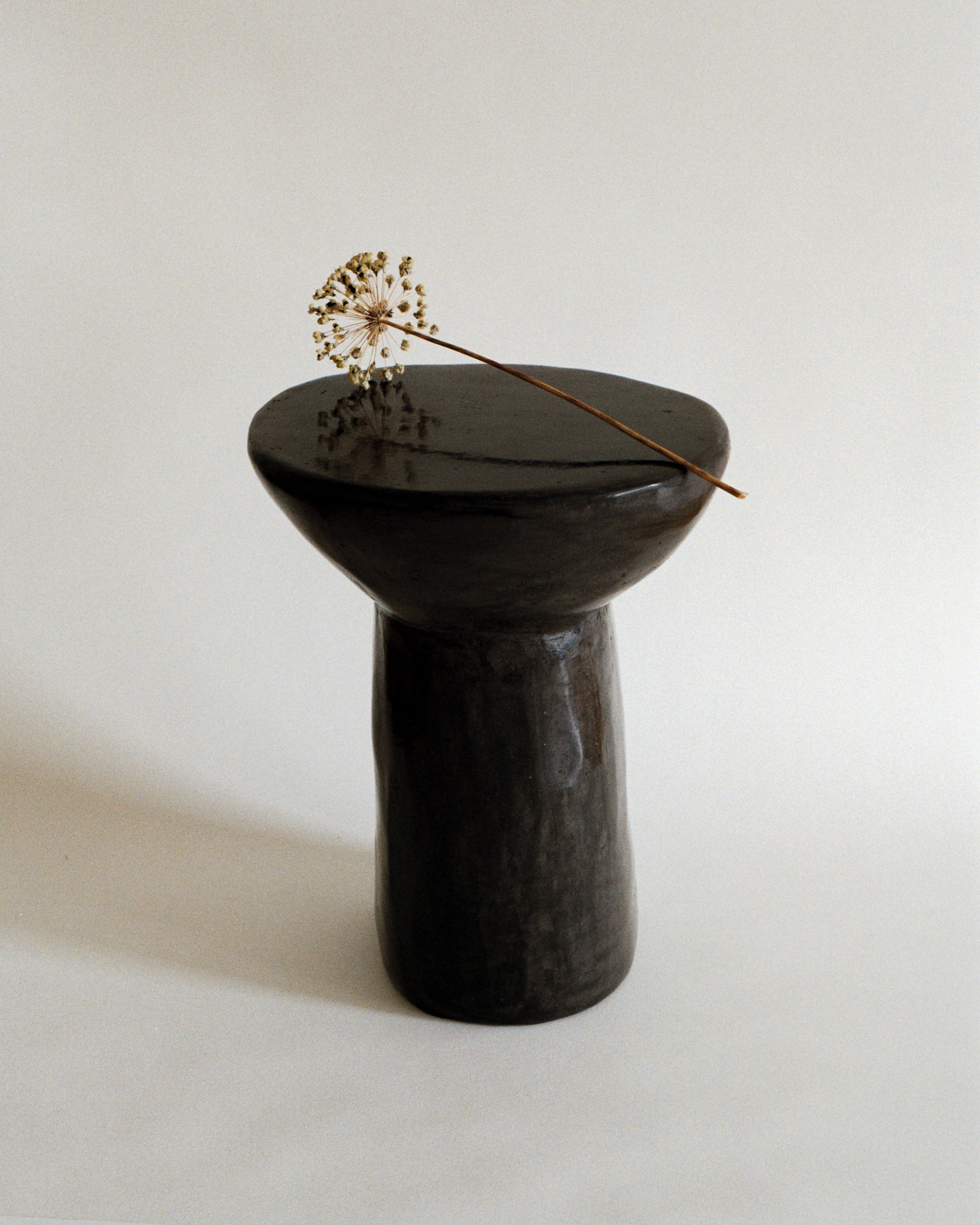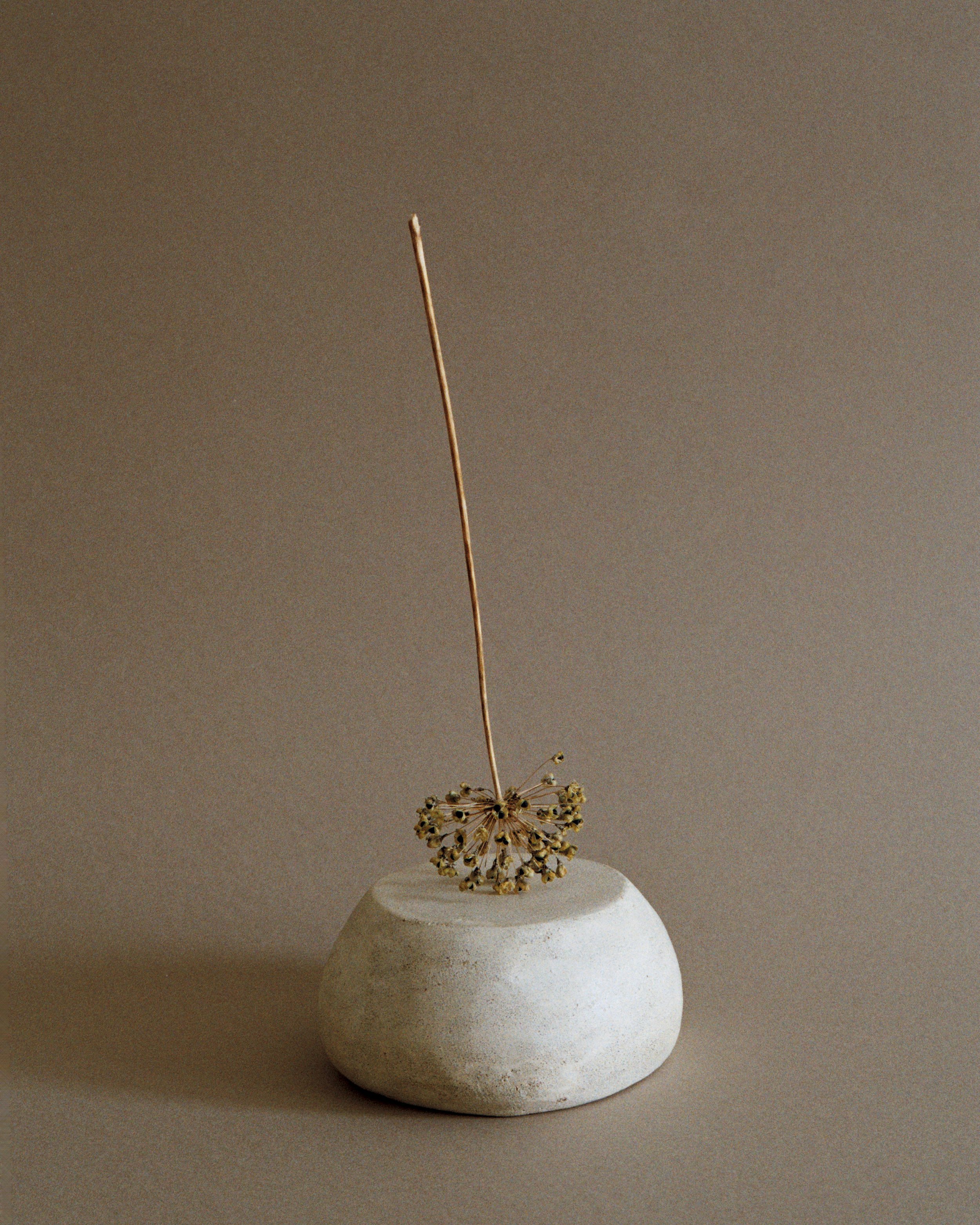Interview #21 Hannah Segerkrantz
Please introduce yourself:
I am Hannah Segerkrantz, a design researcher exploring the world around me through questions regarding radical ecology, material cultures and democratic design. My mission is to bring more harmony between the planet and the people – whether investigating the cultural background and gestures of architectural materials, or studying the relations between objects, people and local traditions, I work towards tools and means for bridging our connection with the environments we inhabit.
I am currently based in Tallinn, Estonia.
Kosmosekivid, © Silver Mikiver
#1 You are known for your work with hempcrete. What is hempcrete and how did you get to work with this material?
Hempcrete is an ecological building material composed of hemp shivs, lime and water, more commonly known in architecture as an isolation material, as it naturally regulates heat and moisture, alongside all its other wonderful qualities.
Process Hemp-it-yourself © Chiara Tichelman
I first found out about hempcrete during my internship with BC Architects & Studies. They had recently finished building a regional house out of hempcrete, and had some excess raw materials in the material lab. I remember spending my evenings in the workshop making samples – it was a love at first sight!
Hempcrete is such a potent material with little to no applications on a smaller scale than walls, yet with amazing qualities in forming and casting. From there I knew it’d be the research subject of one of my graduation projects from the Design Academy Eindhoven, which ended up being a semi-modular method and an open source manual called „Hemp-it-yourself“, which teaches you to work with the material through making side tables casted into textile form works.
Outcome Hemp-it-yourself, © Hannah Segerkrantz
Hempcrete is such a potent material with little to no applications on a smaller scale than walls, yet with amazing qualities in forming and casting.
#2 You have founded your own label KIUKIVI, where you sell objects made of hempcrete, while also offering workshops to teach people about this innovative material. What is particularly important to you in terms of educating people?
I think it is crucial to have more planet-friendly options available, whether speaking of building materials, textiles or food sources. As you’ve learned, hempcrete is not only usable in architecture, it also makes a great natural alternative to sculpture and installation works as a filler material, yet its potential is still largely unexplored.
It is also important to develop a new aesthetics for ecological materials, else they will always carry the often-negative connotation of ‘hippie aesthetics’, which downgrades their potential to a great extent. By bringing people in contact with the material, they get to discover the potential of hempcrete, which often sparks very beautiful expressions in their own practices, or even new collaborative and bigger scale projects.
Through my workshops I of course teach people about the history, qualities and characteristics of hempcrete, but I also bring them in contact with materials and most importantly, with their hands and their intuition. The moment we let our hands guide the process, the heart opens up and often the workshops hold beautiful discussions on very touching topics.
Hemp-it-yourself Workshop, © Kaisa Nele Hendla
Thus, in my ‘teaching’, the importance lies in holistic experiences combining theory and practice for the participants to really understand and feel the materials. ‘Mud and mindfulness’ is one of the best comments a participant has ever given me, and I think that sums it up quite well!
I like to think of Kiukivi’s as totems for ecological design – they are sculptural design elements, but also carbon banks, as the lime that is mixed with water continues to carbonize within the shape over the years of its lifecycle. Hence, I hope that each time my customers look at their Kiukivis they are reminded of that, and of the fact that they get to choose what they invest into – whether that’s supporting ecological initiatives or petrol-based materials.



#3 Tell us something about OFFFENCE which “was a collective pursuit of initiating and developing an autonomous educational program”. How important is working in a collective for you and what do you think are the advantages of doing so?
Collective approaches, whether in education, research or else, are extremely important!
Working in a group is never easy, especially as creatives, yet it can be such a good experience when done in a well-managed and kind way. It allows for everyone to develop their strengths as well as their weaknesses, because frankly everything is triggered and comes to light. But if there’s a safe network and openness for sharing, collectivity can be the fastest way to develop and grow, as well as an efficient and exciting way to work – responsibilities can be divided, different characters can work on different aspects of the project, and there’s always someone to reflect with, when you’re in need of feedback.
OFFFENCE Collective in an abandoned quarry, Matera, IT, © Lucas de Ruiter
OFFFENCE in specific was an alternative educational collective, meaning we were creating our own curricula, living all together, sharing a studio, constantly reflecting on the process through collective therapy sessions and peer-feedback, and self-assessing ourselves based on self-designed evaluation criteria – it was very intense. At times I felt it was more of a social experiment than an educational one, but a huge learning experience nevertheless. All the tools we created can be found on our website: https://offfence.ooo/
OFFFENCE, An experiment in education, zine
#4 You worked as a design researcher and exhibition developer on the project “Cambio – on Finnish forestry” which was shown at the Helsinki Design Museum in 2022. What was it like to work with other experts and researchers and how did you approach the project?
This project was done by Studio Formafantasma, where I was working during that time. Formafantasma is well known for their pioneering approach in design research, and the project was carried out using the working modalities the studio has developed over the years. That being said, it was a very inspiring experience! I realised how potent it is to work with scientists and experts from the field, as often their research remains on the endless pages of scientific articles, having little ground with the rest of the people. When we interviewed them, we understood the topics in much more detail, and were also able to translate their work through the studios perspective and criticality into a visual language. There’s a lot of shared excitement, eagerness and interest in such collaborations!
#5 In addition to your practical work, you also work as a lecturer. What do you want to pass on to young students there?
Although my job title is a lecturer, my courses are always hands on and practical – to engage with the materials and have an embodied experience. In Estonia, my main goal is to pass on openness and play – the schooling there is slightly more traditional and academic, meaning it’s important to open ‘students’ up to experimentation, and make them realise there really is no failure.
Hemp-it-yourself Workshop © Kaisa Nele Hendla
The studios I lead always initiate ‘students’ own agencies and I really encourage them to dive deeper into their own affinities and interests. I’ve realised that’s the most probable way to have them engaged and come to class with shining eyes. There’s nothing better than students who take responsibility for their own education, and actually want to be part of the courses.
Another crucial element for me is horizontality – I call my students ‘participants’ and make sure they understand that although there’s a grading system applied by the institution, within my courses we are all equal, all learning from one another. This is something OFFFENCE taught me, and though it’s challenging to draw the line between being friendly and professional, it’s nevertheless extremely gratifying.
I am now part-taking in a new lecturer role in TU Vienna, as a fellowship of the LINA Community, the goal of which is to develop new materials based on local waste streams and geology, in collaboration with the students and a few other exciting parties. Very curious to experience how it will be to teach in a new cultural context.
#6 What are you currently working on and what are your next steps?
At the moment I am finishing a much more sculptural project – a set of black hempcrete stones commissioned by AERIS, an interior architecture studio. They were interested in meteorite-looking boulders, and together with a local craftsman Andrus Needo (Krohwin) we developed a black hempcrete mixture and casted these huge pieces that will now become carbon banks in a newly opened office. It’s special to have ecological materials in more corporative environments – I do believe the more people are exposed to alternatives, the faster we will move towards a shared understanding of what it means to really be one with nature.
Kosmosekivid © Silver Mikiver
But on the side of that, I am slowly moving my practice more towards design research, as Kiukivi is starting to live its own life. Currently, I am investigating the ecological and historical contexts of sand and glass, and looking into developing new glass-like materials. For this project, I will be working together with geologists, ecologists and sedimentologists to find alternatives to using quartz sand, which is slowly running out on our planet.
Kuusalu sand quarry, © Hannah Segerkrantz
My goal is to lead an interdisciplinary and research-based practice with a site specific approach, looking at material cultures, waste streams, politics, history and ecology of the subjects I am investigating.
#7 How do you see the role of an architect in today's society?
I am starting to romanticise about the idea of the architect being more of a curator or a restaurateur, rather than the one drawing and designing from scratch. I strongly believe architects should engage with materials more, to let them guide the building together with the local context. The more we can make use of existing materials, structures and buildings, the less there is to ‘make’, rather to reorganise and revalue. I think there’s so much more the practice allows for and entails, and I am curious to see where it’ll develop!
#8 How does your environment influence your work?
I’ve noticed quite big changes in my approach and attitude towards my work now that I’ve relocated from the west of Europe back to the north. Our surroundings influence us a lot, as it’s a direct reflection and a response to what we do and how we position ourselves. I noticed I am much more critical when I am engaged in the design scene of The Netherlands for example, as my schooling and network come from a very specific approach to design. In Estonia, it’s much more about subtle communication and finding resonance – there’s less people here, and a very different cultural context, which together can make the situation a bit more solitary. Yet, the context does offer a lot of potential in terms of materials, nature and empty spaces, so I am very eager to find ways and means to bring more people here, instead of reaching abroad for input.
Stories from Kyne, an anthropological research on the island of Kihnu, © Hannah Segerkrantz
Apart from the bigger scale context, I know I always work better when I am in nature, which is why the past two summers I’ve built up a temporary off-grid studio at our family’s old summer house – living with the bare necessities (cold water, no electricity) and cooking on the fire whilst looking at the calm sea really slow down the mind and allow for new inspiration to arrive to the body. I think I’ve done my best works there!
#9 Three things that inspire you at the moment:
Wild Clay, © Hannah Segerkrantz
Nature, always, with its patterns and colours and textures
Geological maps of bedrock and sedimentary covers
Wood carved and turned shapes from traditional crafts
#10 What do you currently read, watch, listen to?
Apart from a huge pile of scientific studies of sand, desertification and the history of glass, I am reading „A Wild Thing“ by Hilde Bouchez, a book that reflects on design history and the latest movements within the design world through phenomenological methodology, arriving to a new unity between a person, a thing and the universe.
I haven’t really taken the time to watch any series or movies, which is a pity. I’d love to dive into the arthouse cinema one day!
When it comes to listening, during periods of more intense work, I prefer to be surrounded by silence – it helps me to focus my thoughts. My all time favourite Estonian artist Erki Pärnoja is most often to be heard in my studio, his music has gotten me out of so many creative halts, for which I am very grateful. But in general, on some days it’s Brian Eno and binaural beats for creativity, on others it’s 80’s disco or world music – it really depends on the day and the mood!
Photo Credits: © Hannah Segerkrantz, © Silver Mikiver, © Kaisa Nele Hendla, © Chiara Tichelman, © Lucas de Ruiter, Interview Caroline Steffen










